Standard [CURRENT]
ASTM D 6417:2025
Standard Test Method for Estimation of Engine Oil Volatility by Capillary Gas Chromatography
- Publication date
- 2025
- Original language
- English
- Pages
- 11
- Publication date
- 2025
- Original language
- English
- Pages
- 11
- DOI
- https://dx.doi.org/10.1520/D6417-25
Product information on this site:
Quick delivery via download or delivery service
Buy securely with a credit card or pay upon receipt of invoice
All transactions are encrypted
Short description
1.1 This test method covers an estimation of the amount of engine oil volatilized at 371 °C (700 °F). 1.1.1 This test method can also be used to estimate the amount of oil volatilized at any temperature between 126 °C and 371 °C, if so desired. 1.2 This test method is limited to samples having an initial boiling point (IBP) greater than 126 °C (259 °F) or the first calibration point and to samples containing lubricant base oils with end points less than 615 °C (1139 °F) or the last n-paraffins in the calibration mixture. By using some instruments and columns, it is possible to extend the useful range of the test method. 1.3 This test method uses the principles of simulated distillation methodology. 1.4 This test method may be applied to both lubricant oil base stocks and finished lubricants containing additive packages. These additive packages generally contain high molecular weight, nonvolatile components that do not elute from the chromatographic column under the test conditions. The calculation procedure used in this test method assumes that all of the sample elutes from the column and is detected with uniform response. This assumption is not true for samples with nonvolatile additives, and application of this test method under such conditions will yield results higher than expected. For this reason, results by this test method are reported as area percent of oil volatilized to 371 °C (700 °F). 1.5 The values stated in SI units are to be regarded as standard. The values stated in inch-pound units are provided for information only. 1.6 This standard does not purport to address all of the safety concerns, if any, associated with its use. It is the responsibility of the user of this standard to establish appropriate safety, health, and environmental practices and determine the applicability of regulatory limitations prior to use. 1.7 This international standard was developed in accordance with internationally recognized principles on standardization established in the Decision on Principles for the Development of International Standards, Guides and Recommendations issued by the World Trade Organization Technical Barriers to Trade (TBT) Committee.
ICS
75.100
DOI
https://dx.doi.org/10.1520/D6417-25
Also available in
Loading recommended items...
Loading recommended items...
Loading recommended items...
Loading recommended items...

